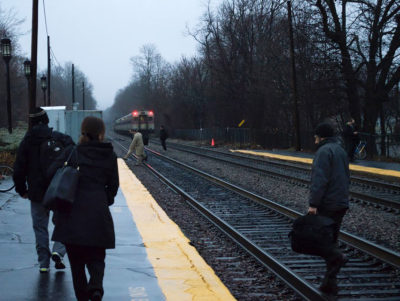
A sudden spike in train-related deaths has garnered the attention of the Massachusetts Bay Transportation Authority and state officials, prompting more public awareness campaigns and the push for solutions to this issue.
Fatal commuter rail collisions for the fiscal year of 2018 are already level or close to those of other years at 11 deaths thus far, according to data provided by MBTA spokesperson Joe Pesaturo. For the entirety of the fiscal year 2017 alone, a total of 19 deaths were reported.
A special task force called the Rail Safety Committee was created to propose solutions aimed at decreasing such accidents. The committee consists of the MBTA, Samaritans Inc. and the Massachusetts Department of Public Health, among others, according to an MBTA PowerPoint.
Pesaturo wrote in an email to The Daily Free Press the cause of the rise of collisions may not be entirely due to the structure of the transit system but a lack of public awareness for safety precautions as well.
“Like every railroad network in the world, the MBTA Commuter Rail system has a number of areas that are unrestricted,” Pesaturo wrote. “This is why railroad operators around the world focus on education and public awareness in efforts to deter and prevent trespassing.”
The MBTA and Keolis have partnered with groups like Operation Lifesaver and Samaritans as a means of increasing awareness of railway safety, Pesaturo wrote.
The MBTA is developing numerous short-term initiatives to help combat this issue, including the development of a tool providing situational awareness and improved communication for Green Line officials, according to the PowerPoint.
Track maintenance and improvements are an additional area of focus for the MBTA, according to the presentation. The current transit system will be inspected and evaluated by a new management team and outside track engineering firms that were hired for this purpose.
Steve Mongeau, executive director of Samaritans, said the MBTA has been one of their main organizers for a few years, stemming back to when the suicide prevention group launched texting on their help line.
“We’ve had well over 7,000 texts and messages on our line, averaging around 500 per month right now,” Mongeau said. “We’re grateful for the fact that they’ve put all that signage around the subway system and we hope to expand that to the commuter rail system.”
Based on the data provided, Mongeau confirmed there has been a significant spike in deaths from collision. While an exact reason behind this surge cannot be pinpointed, Mongeau said, it’s important to draw more attention to the issue and increase safety precautions.
“For them it is a dramatic increase, almost a doubling, for fatalities,” Mongeau said. “That is why they are doing more safety initiatives to help, and bring more awareness to the Samaritans suicide prevention help line for example — to help let people know that there are alternatives out there.”
Evaluation and possible reconstruction of the commuter rail system is a difficult task, and eliminating risk altogether seems almost impossible, but there are possible solutions to help combat the problem as a whole, Mongeau said.
“I do think there are some safety precautions they could take with incremental fencing in some areas or signage,” Mongeau said. “We’ve had people call us on a helpline or text us on a helpline saying that they’ve seen a sign on a commuter rail or a train … solid examples of people seeing the number and reaching out for help.”
Several Boston residents said they did not know about this increase in train-related deaths, but said they suspected that inadequate safety precautions and a lack of mental health resources in the city might be possible factors.
Jasmine Robinson, 27, of Brighton, said she views these incidents as a major tragedy, and expressed that more mental health treatment and support options in the city are necessary.
“It points to the amount and loneliness and depression that happens in a city,” Robinson said. “There needs to be more concern on mental and emotional health in the city. Physical health is very big here, but mentally and emotionally … taking care of ourselves as well is a big issue.”
Emily Lynch, 25, of Allston, said she was not aware of the surge in fatal collisions, but said she questioned whether it was a result of mechanical issues with the trains or suicides.
“I am a nurse so I have taken care of a few people who have attempted suicide and that sticks out in my mind as a potential cause,” Lynch said.
Maxwell McKee, 22, of Fenway, said there should be increased safety precautions and infrastructure improvements to aid in preventing further collisions.
“It’s just a thin yellow line separating it, and I’ve heard about people getting pushed onto the tracks before,” McKee said. “I’ve only been here a month and it’s horrific. Maybe having a guard rail … and maybe more personnel around to monitor it, but it seems like a kind of a difficult issue to guard against.”
Visit www.mass.gov/dph/suicideprevention. Additionally, the Samaritans are available at any time, by phone or by text, at 1-877-870-HOPE (4673). The National Suicide Prevention Lifeline is 1-800-273-TALK (8255).


